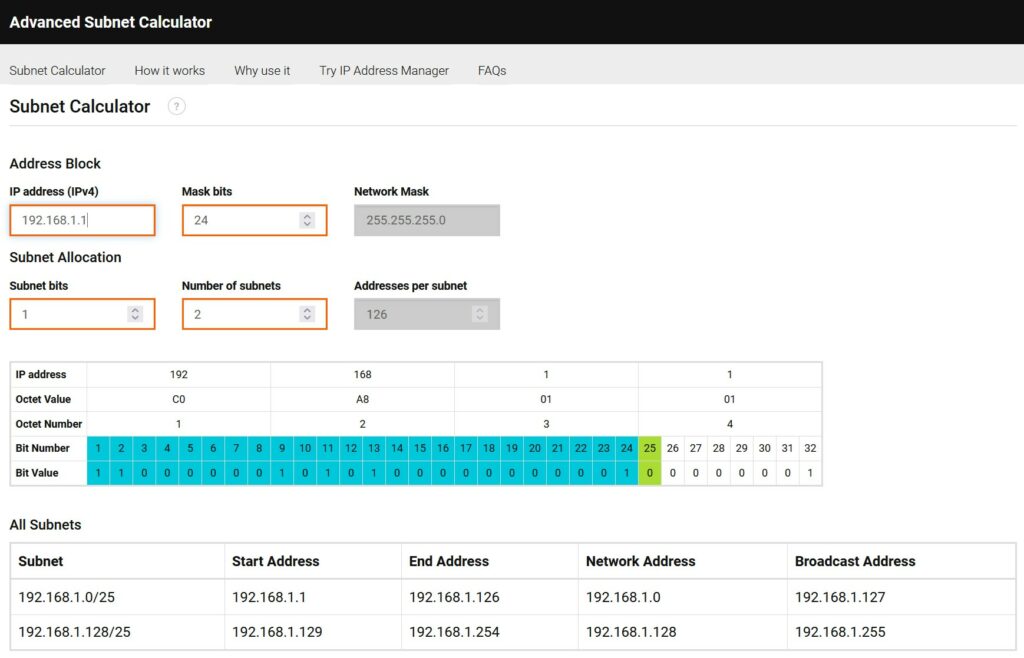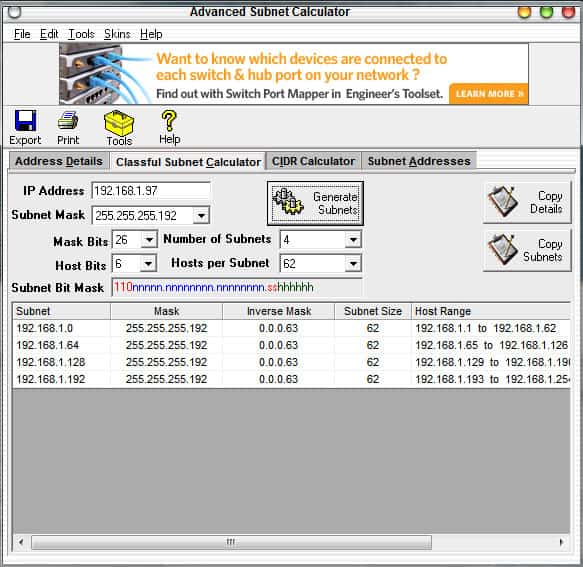Our funding comes from our readers, and we may earn a commission if you make a purchase through the links on our website.
IP Subnet Calculator Software – Download and Easily Divide Address Ranges into Subnets Quickly!

UPDATED: August 28, 2023
Dealing with and managing large, expansive networks can become complex. This complexity is not limited to just the intricacies of the hardware and software but extends to basic tasks such as IP address assignment.
The Utility of Subnets
Utilizing subnets to segment a network into smaller, more manageable portions is a solution that simplifies large-scale network management. However, it introduces its own set of challenges, necessitating precise calculation and assignment.
The Expertise and The Tools
While most experienced technicians are familiar with concepts like Subnetting and CIDR, and might even perform necessary calculations mentally or with simple tools, relying solely on this knowledge can be prone to errors. Fortunately, there's no need for manual calculations given the array of tools available today.
Online vs. Local Subnetting Tools
Many tools for subnet calculation are available online, and their free nature—often supported by ad revenue—makes them a popular choice. However, these online utilities come with their set of drawbacks. They can be plagued with site bugs, unexpected updates, or even complete outages. Moreover, the risk of domain changes without prior notice or the security vulnerabilities introduced by ads or popups makes them less desirable.
The Advantage of Local Utilities
A localized tool that's both straightforward and robust offers a more reliable solution. Such tools, not reliant on online connectivity, promise both reliability and portability. One example of this kind of utility is the SolarWinds Advanced Subnet Calculator.
IP Address Subnetting Calculator from SolarWinds – FREE TOOL
SolarWinds Advanced Subnet Calculator offers many helpful features for the sake of easily calculating addresses, reclaiming/assigning addresses, generating lists of devices and addresses, provisioning, and so forth.
The main window, shown above, has all the basic information for subnetting. The Export allows you to easily export subnet, mask, inverse mask, subnet size, host range, and broadcast data all at once into various formats.
The Tools button opens up a context menu with access to a wide range of other SolarWinds tools which can be easily installed and configured entirely for free!
By default the IP Address is the system's IP address, but of course others may be entered.
By performing a lookup you can pull the data for response time, actual host, address class info for removing masks and exposing subnet details, and even includes a handy full display for both HEX and binary.
The lower portion further expands the subnet and breaks down CIDR information as well as providing owner information or data, if available, for the particular address and subnet range.
Classful Subnet Calculator: Subnetting Simplified
The second tab, titled “Classful Subnet Calculator”, offers a comprehensive toolkit tailored for effortless calculations of subnet values and masks. Here, customization is prioritized, allowing users to define specific characteristics they want in their subnet. With just a few intuitive clicks, you can alter the number of hosts and subnets, and the tool promptly generates a list, providing accurate subnet addresses. Additionally, fundamental subnetting details, such as the subnet bit mask, are displayed. For added clarity, the subnet bit mask is elaborated in its full unmasked length, acting as a handy quick reference.
CIDR Mask Options: Customized Calculations
The third tab, which hasn't been depicted earlier, closely resembles the classful tab. The key distinction is that it incorporates CIDR mask options, catering to those who predominantly use this feature.
Bulk Address Generator: Documentation Made Easy
The subsequent tab is straightforward, primarily functioning as a generator for mass addresses. Users input a specific IP address and subnet mask, and the tool produces the desired list. This feature proves invaluable for documentation purposes or quick referencing.
Aesthetics: Customizing the UI Look
As a touch of customization, the calculator incorporates a ‘Skins' window positioned at the top. As the title suggests, it offers various visual themes for the program's user interface. While it doesn't affect functionality, it does enhance aesthetics.
The SolarWinds Advanced Subnet Calculator offers a range of functionalities. While there are several utilities available for basic subnet calculations, this tool provides additional features. It can create subnets, determine CIDR, generate lists, retrieve address specifics, and perform reverse DNS information lookups. One notable advantage is its offline functionality, which allows for calculations without an internet connection. While it offers these features without a price tag, potential users should assess its capabilities against their specific needs before integration.
IP Subnet Calculator Software FAQs
What are the key features of an IP Subnet Calculator?
The key features of an IP Subnet Calculator include the ability to perform subnetting calculations, calculate subnet masks, determine the number of usable IP addresses in a subnet, and determine the broadcast address for a subnet.
How does an IP Subnet Calculator work?
An IP Subnet Calculator works by using the IP address and subnet mask to perform subnetting calculations and determine the number of usable IP addresses in a subnet, the network address, the broadcast address, and other information.
How do I calculate a subnet mask?
To calculate a subnet mask, you need to determine the number of subnets and hosts required for your network, and use that information to calculate the subnet mask.
What is a VLSM?
VLSM, or Variable Length Subnet Mask, is a technique used to allocate subnets of different sizes within a single IP network. This allows organizations to conserve IP addresses and improve network efficiency.
Related Articles:
Subnet Mask Cheat Sheet – A Tutorial and Thorough Guide to Subnetting!






Free Subnet Calculator 100% FREE Calculator